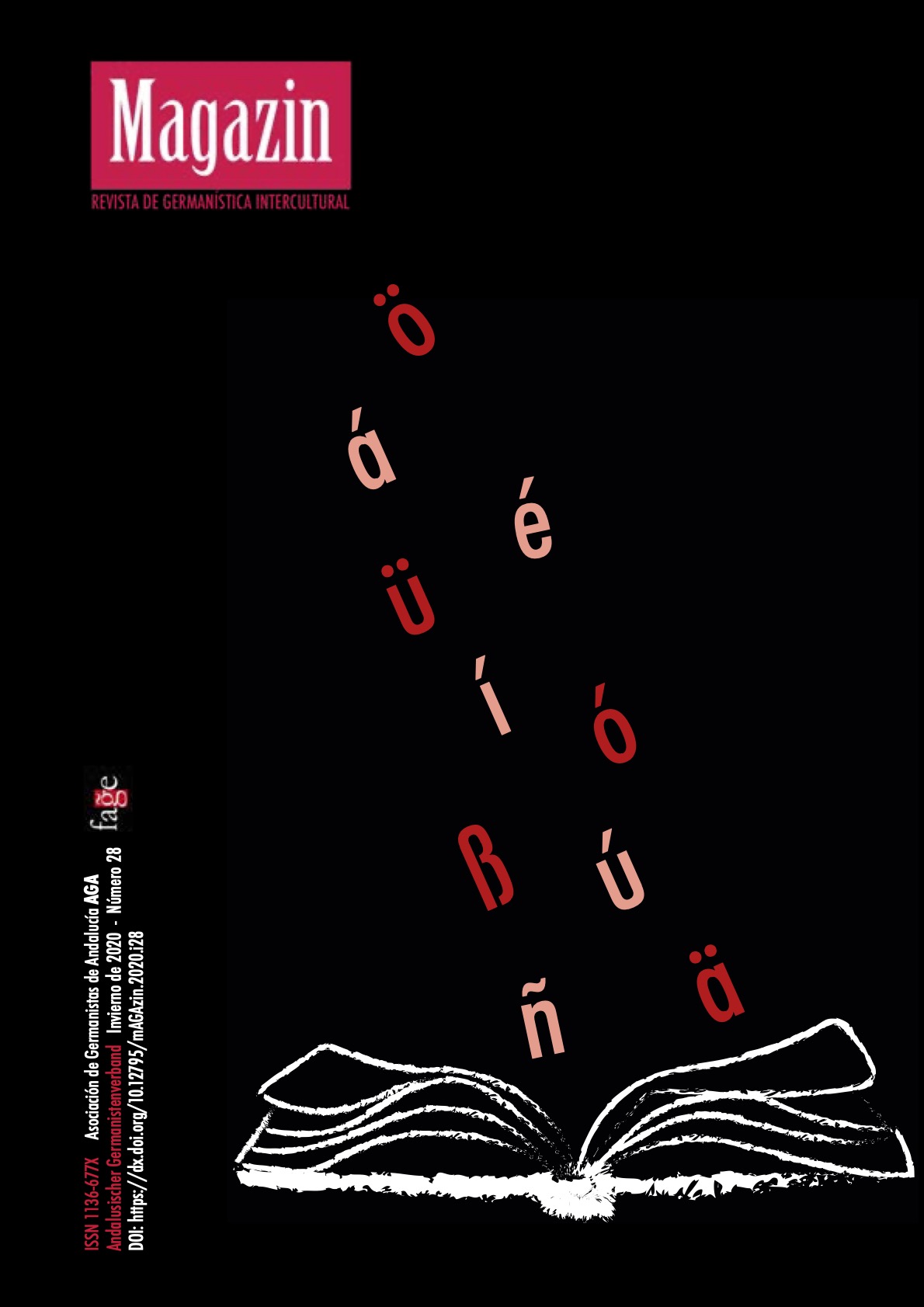German language warm-up exercises in reverse translation classes
DOI:
https://doi.org/10.12795/mAGAzin.2020.i28.03Keywords:
reverse translation, warm-up exercises, motivationAbstract
Many times, there is not enough attention paid to the reality of reverse translation in the professional translation market. In light of this situation, our research collects data about reverse translation market in general and, in particular, about translation into German in Spain. After collecting these data, it is clear that there is a need for the subject of reverse translation in the Spanish curriculum. Furthermore, as university teachers, we must offer our students tools to be able to deal with this subject without fear or anxiety. To this end, we propose a series of warm-up exercises which, at first, are only used in German for Foreigners classes, but which, adapted to the needs of translation students, allow them to become aware of their weaknesses and, in this way, correct any grammatical and structural gaps they may have. Our aim is to open a door to the didactization of the subject of reverse translation, while providing at the same time security and motivation to the students. After putting these exercises into practice in two reverse translation classes in different centres, we see positive results which show that these exercises become basic for the activation of German and translation strategies in our learners
Downloads
References
Beebe-Lonsdale, A. (1966). Teaching translation from Spanish to English. Ottawa: University of Ottawa Press.
Carrión, F. (3 de septiembre de 2018). El pueblo del delta del Nilo que precedió a los faraones. El mundo.
Corpas Pastor, G. (2003). Diez años de investigación en fraseología: análisis sintácticosemánticos, contrastivos y traductológicos. Madrid : Vervuert.
De la Cruz Trainor, M. ( 53-60 de 2004). Traducción inversa: una realidad. Obtenido de Trans N.º 8: https://revistas.uma.es/index.php/trans/article/view/2963/2754/. Última consulta [10/11/2020]
DeKeyser, R.M. (2003). Implicit and explicit learning. En M. y. Long, The handbook of second language acquisition (págs. 487-536). Oxford: Blackwell.
DES. (2000). Department of Education and Science . Obtenido de Learning for Life: Paper on Adult Education : https://files.eric.ed.gov/fulltext/ED471201.pdf. Última consulta [10/11/2020]
García Muruais, M. (1997). Propuestas para la enseñanza de unidades fraseológicas en la clase de E/LE. Actas del VIII Congreso Internacional de ASELE, (págs. 363-370). Alcalá de Henares.
Hansen, Gyde et al. (1998). The translation process: from source text to target text. . En LSP texts and the process of translation (Copenhagen working papers in LSP 1) (págs. 59-72). Copenhagen: Samfundslitteratur.
Haukås, Å.; Malmqvist, A. y Valfridsson, I. (2016). Sprachbewusstheit und Fremdsprachenlernen. Inwiefern fördert die Grammatik in skandinavischen DaF-Lehrwerken die Sprachbewusstheit der Lernenden? . Zeitschrift für Interkulturellen Fremdsprachenunterricht 21, 13-26.
Hurtado Albir, A. (1996). La enseñanza de la traducción. Universitat Jaume I: Servei de Comunicació i Publicacions.
Hurtado Albir, A. (2001). Traducción y traductología, introducción a la traductología. Madrid: Cátedra.
Kay, P. (1992). At least. En A. y. Lehrer, Frames, Fields and Contrasts (págs. 309-331). Hillsdale : Lawrence Erlbaum.
Kelly, D.; Nobs, M; Sánchez, D y Way C. (2003). Reflexiones en torno a algunos conceptos básicos. En K. et al., La direccionalidad en traducción e interpretación (págs. 33-41). Granada: Atrio.
Krenn, W. (2002). Grammatik und Motivation – ein Widerspruch? - Motivierungschancen und -strategien im Grammatikunterricht. Obtenido de Fremdsprache Deutsch: https://fremdsprachedeutschdigital.de/ce/grammatik-und-motivation-ein-widerspruch/detail.html. Última consulta [10/11/2020].
Martina, N. (2012). La guerra contra la traducción a la lengua no materna. Tesina del Máster de Traducción. Utrecht: Universidad de Utrecht.
McAlester, G. (1992). Teaching translation into a foreign language – status, scope and aims. En C. y. Dollerup, Teaching translation and interpreting (págs. 291-297). Ámsterdam / Filadelfia: John Benjamins.
Newpark, P. (1988). A Textbook of Translation. Londres: Prentice Hall.
Norris, J. y. (2008). Effectiveness of L2 instruction: A research synthesis and quantitative meta-analysis. Language Learning, 417-528.
Pavlovic, N. (2007). Directionality in collaborative translation processes - A Study of Novice Translators. Obtenido de Universitat Rovira i Virgili (España); University of Zagreb, Croatia: https://www.tdx.cat/bitstream/handle/10803/8770/THESIS.pdf?seque. Última consulta [10/11/2020].
Pérez Macías, L. (2017). La práctica de la traducción inersa hacia la lengu aalemana en España.En Magazin n.º 25 (págs. 26-32). Obtenido de https://dialnet.unirioja.es/servlet/articulo?codigo=6763840. Última consulta [10/11/2020]
Piñeiro, M. y Navarro, D. (2008). The Architecture of Pedagogy in the Practice Teaching Experience (PTE) of English as a Foreign Language: A New Proposal to Evaluate Practicum Students; pág. 169-187. Obtenido de Inter Sedes, IX: http://citeseerx.ist.psu.edu/viewdoc/download?doi=10.1.1.854.7356&rep=rep1&type=pdf. Última consulta [10/11/2020].
Piróth, A. (enero de 2015). Translation into a non-native language . Obtenido de IAPTI’s Ethics Committee: https://www.iapti.org/files/surveys/2/IAPTI_non-native_report.pdf. Última consulta [10/11/2020].
Raabe, H. (2003). Grammatikübungen. En K. Bausch, & H. &. Christ, Handbuch Fremdsprachenunterricht (págs. 283-286). Tübingen y Basilea: Francke.
Roiss, S. y Weatherby, J. (2001). A Need for Reorientation: Creative Strategies for the Teaching of Translation into a Foreing language. En A. B. al., Translator’s Strategies and Creativity (págs. 213-222). Amsterdam: J. Benjamins.
Sevilla, M. (2012). Utilización de recursos en línea en la enseñanza/aprendizaje de traducción de unidades fraseológicas. En I. Cervantes, Unidades fraseológicas y TIC (págs. 283-298). Biblioteca fraseológica y paremiológica, Instituto Cervantes.
Stewart, D. (2000). Poor Relations and Black Sheep in Translation Studies. Target, 205-228.
Velandia, R. (2008). The Role of Warming Up Activities in Adolescent Students' Involvement during the English Class. Obtenido de Profile Issues in Teachers' Professional Development n.º 10; pp. 9-26: http://www.redalyc.org/pdf/1692/169214143002.pdf. Última consulta [10/11/2020]
Wimmer, S. (2011). Tesis Doctoral: El proceso de la traducción especializada inversa: modelo, validación empírica y aplicación didáctica. Obtenido de Universitat Autònoma de Barcelona: Wimmer (2011:27-31/ El proceso de la traducción especializada inversa: modelo, validación empírica y aplicación didáctica, tesis doctoral, Universitat Autònoma de Barcelona.
Published
How to Cite
Issue
Section
License
Self-archiving policy
Romeo Blue Journal (applied)
Only editor PDF can be archived
Author cannot archive the pre-print version
Author cannot archive the postprint version
- Abstract 211
- PDF (Español (España)) 381
- EPUB (Español (España)) 19
- HTML (Español (España)) 61




